合金计算
728铝合金下料计算公式

728铝合金下料计算公式728铝合金是一种常见的铝合金材料,常用于航空航天、汽车制造、船舶制造等领域。
在使用728铝合金进行下料加工时,需要进行一定的计算和规划,以确保材料的利用率和加工质量。
下面将介绍下728铝合金下料的计算公式和相关知识。
728铝合金下料计算公式如下:1. 材料重量计算公式:材料重量(kg)= 面积(m²)×材料厚度(mm)×材料密度(g/cm³)/ 1000。
2. 材料面积计算公式:材料面积(m²)= 长度(mm)×宽度(mm)/ 1000000。
3. 材料利用率计算公式:材料利用率(%)= 实际利用面积(m²)/ 理论面积(m²)× 100%。
以上是常用的728铝合金下料计算公式,下面将对每个公式进行详细解释和应用。
首先是材料重量计算公式。
在进行下料加工时,需要根据设计要求和零件尺寸来确定所需的材料重量。
通过材料重量计算公式,可以准确地计算出所需材料的重量,从而避免材料的浪费和不足。
其次是材料面积计算公式。
在进行下料加工时,需要根据零件的尺寸和形状来确定所需的材料面积。
通过材料面积计算公式,可以快速准确地计算出所需材料的面积,为后续的下料加工提供准确的数据支持。
最后是材料利用率计算公式。
材料利用率是衡量材料利用程度的重要指标,对于节约材料和降低成本具有重要意义。
通过材料利用率计算公式,可以及时了解材料的利用情况,从而进行合理的规划和调整,提高材料的利用率和加工效率。
除了上述的计算公式,还需要注意以下几点:1. 确定材料的厚度和密度。
728铝合金的密度约为2.7g/cm³,而厚度则根据具体的设计要求和零件尺寸来确定。
2. 注意材料的规格和尺寸。
在进行下料加工前,需要根据设计要求和零件尺寸来选择合适的材料规格和尺寸,以确保加工质量和材料利用率。
3. 合理安排下料方式。
根据零件的形状和尺寸,合理安排下料方式可以提高材料的利用率和加工效率,减少浪费和成本。
镍基合金重量公式

镍基合金重量公式镍基合金重量公式是指计算镍基合金重量的数学公式。
镍基合金是一种含有镍元素占比较高的合金材料,通常用于制造高温、腐蚀性环境下的零件和设备。
对于工程师和科研人员来说,了解并掌握镍基合金重量的计算方法是非常重要的。
计算镍基合金重量的公式主要基于合金的密度和几何形状。
密度是指单位体积的物质质量,通常用克/立方厘米或克/立方米来表示。
而几何形状则包括材料的长度、宽度、厚度等尺寸。
根据这些参数,我们可以通过以下公式来计算镍基合金的重量:重量 = 密度× 长度× 宽度× 厚度在实际应用中,镍基合金的密度可以通过实验测量获得,也可以在材料手册或相关文献中找到。
根据具体的合金成分和制造工艺,镍基合金的密度通常在8.2-9.2克/立方厘米之间。
需要注意的是,公式中的长度、宽度和厚度应该使用相同的单位进行计算。
通常情况下,我们会将尺寸统一转换为厘米或米,以保证计算结果的准确性。
举个例子来说明,假设我们要计算一块尺寸为10厘米×5厘米×2厘米的镍基合金的重量,该合金的密度为8.5克/立方厘米。
首先,我们将尺寸转换为相同的单位,比如厘米。
然后,将这些值代入公式进行计算:重量 = 8.5克/立方厘米× 10厘米× 5厘米× 2厘米= 850克因此,这块镍基合金的重量为850克。
需要注意的是,镍基合金的重量计算公式适用于各种形状的材料,包括板材、棒材、管材等。
对于复杂形状的材料,可以将其分解为多个简单形状进行计算,然后将结果进行累加。
掌握镍基合金重量的计算方法对于工程师和科研人员来说是非常重要的。
通过合金的密度和几何形状,我们可以使用镍基合金重量公式来计算出合金的重量,从而为材料设计和工程应用提供准确的数据支持。
合金计算公式

NO.陈运强元素纯金属%纯金/合金合金%合金%整铝锭质量/g2219 0Cr Al92.400%100.00%80.5356%1378.6 Zn0.000%100.00%0.0000000000000000%0.0000%Mg0.000%100.00%0.0000000000000000%0.0000%Cu 6.250%49.80%12.5502008032129000%12.5502%Zr0.120% 4.35% 2.7586206896551700% 2.7586%Cr0.000% 4.89%0.0000000000000000%0.0000%Mn0.300%10.00% 3.0000000000000000% 3.0000%Ti0.050% 4.95% 1.0101010101010100% 1.0101%V0.080%55%0.1454545454545450%0.1455%Si0.000%20%0.0000000000000000%0.0000%100.000%100.000%NO.陈运强元素纯金属%纯金/合金合金%合金%整铝锭质量/g22190.04CrAl92.360%100.00%79.7176%1372.8Zn0.000%100.00%0.0000000000000000%0.0000%Mg0.000%100.00%0.0000000000000000%0.0000%Cu 6.250%49.80%12.5502008032129000%12.5502%Zr0.120% 4.35% 2.7586206896551700% 2.7586%Cr0.040% 4.89%0.8179959100204500%0.8180%Mn0.300%10.00% 3.0000000000000000% 3.0000%Ti0.050% 4.95% 1.0101010101010100% 1.0101%V0.080%55%0.1454545454545450%0.1455%Si0.000%20%0.0000000000000000%0.0000%100.000%100.000%NO.陈运强元素纯金属%纯金/合金合金%合金%整铝锭质量/g22190.10CrAl92.300%100.00%78.4906%1338.4Zn0.000%100.00%0.0000000000000000%0.0000%Mg0.000%100.00%0.0000000000000000%0.0000%Cu 6.250%49.80%12.5502008032129000%12.5502%Zr0.120% 4.35% 2.7586206896551700% 2.7586%Cr0.100% 4.89% 2.0449897750511200% 2.0450%Mn0.300%10.00% 3.0000000000000000% 3.0000%Ti0.050% 4.95% 1.0101010101010100% 1.0101%V0.080%55%0.1454545454545450%0.1455%Si0.000%20%0.0000000000000000%0.0000%100.000%100.000%NO.陈运强元素纯金属%纯金/合金合金%合金%整铝锭质量/g22190.15CrAl92.250%100.00%77.4681%1359Zn0.000%100.00%0.0000000000000000%0.0000%Mg0.000%100.00%0.0000000000000000%0.0000%Cu 6.250%49.80%12.5502008032129000%12.5502%Zr0.120% 4.35% 2.7586206896551700% 2.7586%Cr0.150% 4.89% 3.0674846625766900% 3.0675%Mn0.300%10.00% 3.0000000000000000% 3.0000%Ti0.050% 4.95% 1.0101010101010100% 1.0101%V0.080%55%0.1454545454545450%0.1455%Si0.000%20%0.0000000000000000%0.0000%100.000%100.000%NO.陈运强元素纯金属%纯金/合金合金%合金%整铝锭质量/g22190.02SiAl92.380%100.00%80.4356%1354.2Zn0.000%100.00%0.0000000000000000%0.0000%Mg0.000%100.00%0.0000000000000000%0.0000%Cu 6.250%49.80%12.5502008032129000%12.5502%Zr0.120% 4.35% 2.7586206896551700% 2.7586%Cr0.000% 4.89%0.0000000000000000%0.0000%Mn0.300%10.00% 3.0000000000000000% 3.0000%Ti0.050% 4.95% 1.0101010101010100% 1.0101%V0.080%55%0.1454545454545450%0.1455%Si0.020%20%0.1000000000000000%0.1000%100.000%100.000%NO.陈运强元素纯金属%纯金/合金合金%合金%整铝锭质量/g22190.06SiAl92.340%100.00%80.2356%1372.8Zn0.000%100.00%0.0000000000000000%0.0000%Mg0.000%100.00%0.0000000000000000%0.0000%Cu 6.250%49.80%12.5502008032129000%12.5502%Zr0.120% 4.35% 2.7586206896551700% 2.7586%Cr0.000% 4.89%0.0000000000000000%0.0000%Mn0.300%10.00% 3.0000000000000000% 3.0000%Ti0.050% 4.95% 1.0101010101010100% 1.0101%V0.080%55%0.1454545454545450%0.1455%Si0.060%20%0.3000000000000000%0.3000%100.000%100.000%NO.陈运强元素纯金属%纯金/合金合金%合金%整铝锭质量/g22190.10SiAl92.300%100.00%80.0356%1362.8Zn0.000%100.00%0.0000000000000000%0.0000%Mg0.000%100.00%0.0000000000000000%0.0000%Cu 6.250%49.80%12.5502008032129000%12.5502%Zr0.120% 4.35% 2.7586206896551700% 2.7586%Cr0.000% 4.89%0.0000000000000000%0.0000%Mn0.300%10.00% 3.0000000000000000% 3.0000%Ti0.050% 4.95% 1.0101010101010100% 1.0101%V0.080%55%0.1454545454545450%0.1455%Si0.100%20%0.5000000000000000%0.5000%100.000%100.000%NO.陈运强元素纯金属%纯金/合金合金%合金%整铝锭质量/g22190.15SiAl92.250%100.00%79.7856%1320.8Zn0.000%100.00%0.0000000000000000%0.0000%Mg0.000%100.00%0.0000000000000000%0.0000%Cu 6.250%49.80%12.5502008032129000%12.5502%Zr0.120% 4.35% 2.7586206896551700% 2.7586%Cr0.000% 4.89%0.0000000000000000%0.0000%Mn0.300%10.00% 3.0000000000000000% 3.0000%Ti0.050% 4.95% 1.0101010101010100% 1.0101%V0.080%55%0.1454545454545450%0.1455%Si0.150%20%0.7500000000000000%0.7500%100.000%100.000%总质量/g 合金质量/g烧损/g0Cr0.04Cr0.1Cr1711.7890811378.600Al1378.61321.41338.40.0000.000Zn0000.0000.000Mg000214.833Cu214.832967208.0322252214.002462147.222Zr47.2217677545.726917847.039217060.000Cr013.5591065134.8705852451.354Mn51.3536724349.7280231151.1551485517.291Ti17.290798816.7434421317.223955742.490V 2.489875027 2.411055666 2.4802496270.000Si0001711.7891711.7891711.7890811657.600771705.171618总质量/g 合金质量/g烧损/g0.02Si0.06Si0.1Si1722.0783541372.800Al1354.21372.81362.80.0000.000Zn0000.0000.000Mg000216.124Cu211.2929732214.7290073213.69751447.506Zr46.4436527147.1989166846.9721873514.087Cr00051.662Mn50.5074723251.3288218951.0822537417.395Ti17.0058829417.2824316117.199412032.505V 2.448847143 2.488670152 2.4767153330.000Si 1.683582411 5.1328821898.5137089571722.0781722.0781683.5824111710.960731702.741791总质量/g 合金质量/g烧损/g NO.陈运强元素纯金属%1705.1716181338.4002219 0.15Cr工业Al92.250%0.0000.000Zn0.000%0.0000.000Mg0.000%214.002Cu 6.250%47.039Zr0.120%34.871Cr0.150%51.155Mn0.300%17.224Ti0.050%2.480V0.080%0.000Si0.000%1705.1721705.172100.000%总质量/g 合金质量/g烧损/g NO.陈运强元素纯金属%1754.26961359.0002219 0.02Si工业Al92.380%0.0000.000Zn0.000%0.0000.000Mg0.000%220.164Cu 6.250%48.394Zr0.120%53.812Cr0.000%52.628Mn0.300%17.720Ti0.050%2.552V0.080%0.000Si0.020%1754.2701754.270100.000%总质量/g 合金质量/g烧损/g NO.陈运强元素纯金属%1683.5824111354.2002219 0.10Si工业Al92.300%0.0000.000Zn0.000%0.0000.000Mg0.000%211.293Cu 6.250%46.444Zr0.120%0.000Cr0.000%50.507Mn0.300%17.006Ti0.050%2.449V0.080%1.684Si0.100%1683.5821683.582100.000%总质量/g 合金质量/g烧损/g工业Al1710.960731372.800Zn0.0000.000Mg0.0000.000Cu214.729Zr47.199Cr0.000Mn51.329Ti17.282V2.489Si5.133总1710.9611710.961NO.陈运强元素纯金属%总质量/g 合金质量/g烧损/g2219 0.10Si工业Al92.500%1702.7417911362.800Zn0.000%0.0000.000Mg0.000%0.0000.000Cu 6.100%213.698Zr0.110%46.972Cr0.000%0.000Mn0.360%51.082Ti0.050%17.199V0.080%2.477Si0.000%8.514100.000%1702.7421702.742总质量/g 合金质量/g烧损/g1655.4360941320.8000.0000.0000.0000.000207.76145.6670.00049.66316.7222.40812.4161655.4361655.4360.15Cr合金质量/g合金质量/g合金质量/g合金质量/g13591354.21372.81362.81320.8 0000000000 220.1643575211.2929732214.7290073213.697514207.7605539 48.3936441546.4436527147.1989166846.9721873545.66720259 53.811950930000 52.6280880150.5074723251.3288218951.0822537449.66308281 17.7198949517.0058829417.2824316117.1994120316.72157671 2.551664873 2.448847143 2.488670152 2.476715333 2.4079070460 1.683582411 5.1328821898.51370895712.41577071754.26961683.5824111710.960731702.7417911655.436094 0.15Si1320.8207.760553945.6672025949.6630828116.721576712.40790704612.41577071655.436094纯金/合金合金%合金%整铝锭质量/g总质量/g99.50%92.7135678391960000%77.4681%1379.81781.119349100.00%0.0000000000000000%0.0000%100.00%0.0000000000000000%0.0000%49.80%12.5502008032129000%12.5502%0.9954.35% 2.7586206896551700% 2.7586%04.89% 3.0674846625766900% 3.0675%10.00% 3.0000000000000000% 3.0000%4.95% 1.0101010101010100% 1.0101%55%0.1454545454545450%0.1455%20%0.0000000000000000%0.0000%100.000%纯金/合金合金%合金%整铝锭质量/g总质量/g99.50%80.4356%1391.41729.830576100.00%0.0000000000000000%0.0000%100.00%0.0000000000000000%0.0000%49.80%12.5502008032129000%12.5502%1391.44.35% 2.7586206896551700% 2.7586%0.9954.89%0.0000000000000000%0.0000%1384.44310.00% 3.0000000000000000% 3.0000%4.95% 1.0101010101010100% 1.0101%55%0.1454545454545450%0.1455%20%0.1000000000000000%0.1000%100.000%纯金/合金合金%合金%整铝锭质量/g总质量/g99.50%80.0356%1369.21710.738231100.00%0.0000000000000000%0.0000%100.00%0.0000000000000000%0.0000%49.80%12.5502008032129000%12.5502%1327.84.35% 2.7586206896551700% 2.7586%0.9954.89%0.0000000000000000%0.0000%1321.16110.00% 3.0000000000000000% 3.0000%4.95% 1.0101010101010100% 1.0101%55%0.1454545454545450%0.1455%20%0.5000000000000000%0.5000%100.000%0.04Cr0.1Si1372.81369.20000216.1242915214.701083247.5056097847.1927787814.08653051051.6623506351.3221469217.3947308517.280184152.504841243 2.48834651708.5536911531722.0783541710.738231纯金/合金合金%合金%整铝锭质量/g总质量/g 100.00%86.6157%464.4536.1614035100.00%0.0000000000000000%0.0000%100.00%0.0000000000000000%0.0000%100.00% 6.1000000000000000% 6.1000%1327.8 4.35% 2.5287356321839100% 2.5287%0.995 4.89%0.0000000000000000%0.0000%1321.161 10.00% 3.6000000000000000% 3.6000%4.95% 1.0101010101010100% 1.0101%55%0.1454545454545450%0.1455%20%0.0000000000000000%0.0000%100.000%合金质量烧损/g /g1379.8000.0000.000 0.0000.000 223.53449.13454.63653.43417.9912.5910.0001781.1191781.119合金质量烧损/g /g1391.4000.0000.000 0.0000.000 217.09747.7190.00051.89517.4732.5161.7301729.8311729.831合金质量烧损/g /g1369.2000.0000.000 0.0000.000 214.70147.1930.00051.32217.2802.4888.5541710.7381710.738合金质量烧损/g /g464.4000.0000.000 0.0000.000 32.70613.5580.00019.3025.4160.7800.000536.161536.161。
铝合金的重量计算方法

铝合金的重量计算方法嘿,咱今儿个就来聊聊铝合金的重量计算方法。
你可别小瞧这事儿,就跟咱过日子算开销一样重要呢!铝合金,那可是咱生活里常见的材料呀。
想象一下,那些漂亮的门窗、精致的汽车零件,好多都是铝合金做的呢。
那要怎么算出它的重量呢?其实啊,就像解一道有趣的谜题。
首先呢,咱得知道铝合金的密度。
这就好比每个人都有自己的性格特点一样,铝合金也有它独特的密度。
一般来说,铝合金的密度大概在 2.7 克每立方厘米左右。
不过呢,可别死记硬背这个数字哦,不同种类的铝合金密度可能会有点小差别呢。
然后呢,咱就得来量一量铝合金的体积啦。
这就像是给它量身材一样。
如果是个规则的形状,比如长方体或者圆柱体,那就好办啦,长乘宽乘高,或者底面积乘高,就能算出体积咯。
可要是遇到个奇奇怪怪形状的铝合金咋办呢?嘿嘿,那咱就得动点小脑筋,把它拆分成几个规则的部分来分别计算,然后加在一起。
算出来体积后,那就简单啦,用体积乘以密度,不就得出重量啦!这就好比是把一个人的身高和体重联系起来一样自然。
你说这计算铝合金重量难不难?其实啊,只要掌握了方法,就跟吃饭睡觉一样平常。
就像咱走路,走得多了自然就熟练了。
咱再打个比方,假如你要给家里换个铝合金的窗框,你不得先知道它大概有多重,好安排安装的事儿呀。
要是算错了重量,到时候搬不动可就尴尬啦!或者你是个工程师,设计个铝合金的产品,重量计算不准确,那可会影响整个产品的性能和质量呢。
所以说呀,这铝合金的重量计算方法可真是实用得很呢!咱可不能小瞧了它。
学会了这一招,以后碰到铝合金的东西,咱心里就有底啦,就像有了一把万能钥匙,能打开很多知识的大门。
总之呢,铝合金的重量计算方法看似简单,实则暗藏玄机。
咱得用心去琢磨,多实践实践,才能真正掌握它的精髓。
这样咱在生活和工作中遇到和铝合金有关的事儿,就能轻松应对啦!不用再担心算错啦,多棒呀!你说是不是呢?。
铝合金扁锭重量计算公式
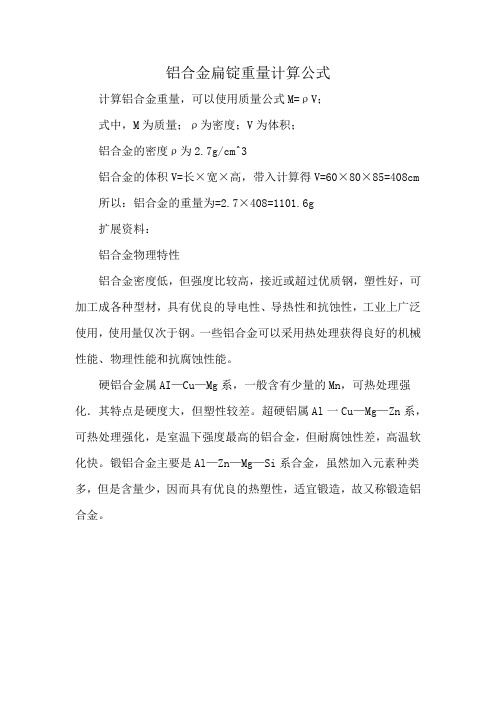
铝合金扁锭重量计算公式
计算铝合金重量,可以使用质量公式M=ρV;
式中,M为质量;ρ为密度;V为体积;
铝合金的密度ρ为2.7g/cm^3
铝合金的体积V=长×宽×高,带入计算得V=60×80×85=408cm 所以:铝合金的重量为=2.7×408=1101.6g
扩展资料:
铝合金物理特性
铝合金密度低,但强度比较高,接近或超过优质钢,塑性好,可加工成各种型材,具有优良的导电性、导热性和抗蚀性,工业上广泛使用,使用量仅次于钢。
一些铝合金可以采用热处理获得良好的机械性能、物理性能和抗腐蚀性能。
硬铝合金属AI—Cu—Mg系,一般含有少量的Mn,可热处理强化.其特点是硬度大,但塑性较差。
超硬铝属Al一Cu—Mg—Zn系,可热处理强化,是室温下强度最高的铝合金,但耐腐蚀性差,高温软化快。
锻铝合金主要是Al—Zn—Mg—Si系合金,虽然加入元素种类多,但是含量少,因而具有优良的热塑性,适宜锻造,故又称锻造铝合金。
锌合金材料计算公式
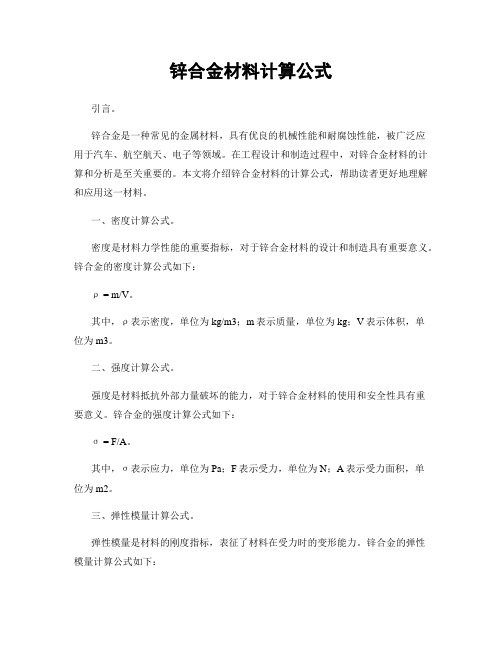
锌合金材料计算公式引言。
锌合金是一种常见的金属材料,具有优良的机械性能和耐腐蚀性能,被广泛应用于汽车、航空航天、电子等领域。
在工程设计和制造过程中,对锌合金材料的计算和分析是至关重要的。
本文将介绍锌合金材料的计算公式,帮助读者更好地理解和应用这一材料。
一、密度计算公式。
密度是材料力学性能的重要指标,对于锌合金材料的设计和制造具有重要意义。
锌合金的密度计算公式如下:ρ = m/V。
其中,ρ表示密度,单位为kg/m3;m表示质量,单位为kg;V表示体积,单位为m3。
二、强度计算公式。
强度是材料抵抗外部力量破坏的能力,对于锌合金材料的使用和安全性具有重要意义。
锌合金的强度计算公式如下:σ = F/A。
其中,σ表示应力,单位为Pa;F表示受力,单位为N;A表示受力面积,单位为m2。
三、弹性模量计算公式。
弹性模量是材料的刚度指标,表征了材料在受力时的变形能力。
锌合金的弹性模量计算公式如下:E = σ/ε。
其中,E表示弹性模量,单位为Pa;σ表示应力,单位为Pa;ε表示应变,无单位。
四、热膨胀系数计算公式。
热膨胀系数是材料在温度变化时长度变化的比例系数,对于锌合金材料的应用和工程设计具有重要意义。
锌合金的热膨胀系数计算公式如下:α = (L2 L1)/(L1 (T2 T1))。
其中,α表示热膨胀系数,单位为℃-1;L1、L2表示材料在温度T1、T2下的长度,单位为m;T1、T2表示温度,单位为℃。
五、热导率计算公式。
热导率是材料传导热量的能力指标,对于锌合金材料的热处理和应用具有重要意义。
锌合金的热导率计算公式如下:λ = q/(A ΔT)。
其中,λ表示热导率,单位为W/(m·K);q表示传热量,单位为W;A表示传热面积,单位为m2;ΔT表示温度差,单位为K。
结论。
锌合金材料是一种重要的金属材料,在工程设计和制造中得到广泛应用。
本文介绍了锌合金材料的密度、强度、弹性模量、热膨胀系数和热导率的计算公式,希望能够帮助读者更好地理解和应用这一材料。
铝合金材质重量计算公式
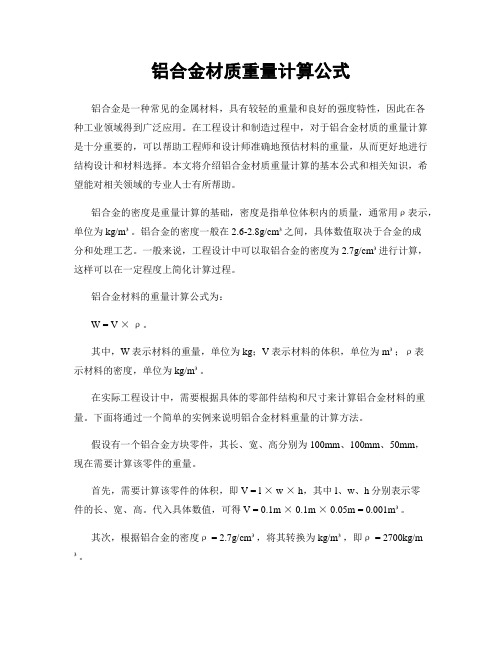
铝合金材质重量计算公式铝合金是一种常见的金属材料,具有较轻的重量和良好的强度特性,因此在各种工业领域得到广泛应用。
在工程设计和制造过程中,对于铝合金材质的重量计算是十分重要的,可以帮助工程师和设计师准确地预估材料的重量,从而更好地进行结构设计和材料选择。
本文将介绍铝合金材质重量计算的基本公式和相关知识,希望能对相关领域的专业人士有所帮助。
铝合金的密度是重量计算的基础,密度是指单位体积内的质量,通常用ρ表示,单位为kg/m³。
铝合金的密度一般在2.6-2.8g/cm³之间,具体数值取决于合金的成分和处理工艺。
一般来说,工程设计中可以取铝合金的密度为2.7g/cm³进行计算,这样可以在一定程度上简化计算过程。
铝合金材料的重量计算公式为:W = V ×ρ。
其中,W表示材料的重量,单位为kg;V表示材料的体积,单位为m³;ρ表示材料的密度,单位为kg/m³。
在实际工程设计中,需要根据具体的零部件结构和尺寸来计算铝合金材料的重量。
下面将通过一个简单的实例来说明铝合金材料重量的计算方法。
假设有一个铝合金方块零件,其长、宽、高分别为100mm、100mm、50mm,现在需要计算该零件的重量。
首先,需要计算该零件的体积,即V = l × w × h,其中l、w、h分别表示零件的长、宽、高。
代入具体数值,可得V = 0.1m × 0.1m × 0.05m = 0.001m³。
其次,根据铝合金的密度ρ = 2.7g/cm³,将其转换为kg/m³,即ρ = 2700kg/m ³。
最后,代入公式W = V ×ρ,即可得到该铝合金方块零件的重量:W = 0.001m³× 2700kg/m³ = 2.7kg。
通过以上计算过程,可以得知该铝合金方块零件的重量为2.7kg。
合金配料计算

合金加入量的计算钢水量校核及碳钢、低合金钢的合金加入量计算A 钢水量校核实际生产中,由于计量不准,炉料质量波动大或操作的因素(如吹氧铁损、大沸腾跑钢、加铁矿等),会出现钢液的实际重量与计划重量不符,给化学成分的控制及钢的浇铸造成困难。
因此,校核钢液的实际重量是正确计算合金加入量的基础。
首先找一个在合金钢中收得率比较稳定的元素,根据其分析增量和计算增量来校对钢液量。
计算公式为:PΔM=PoΔMo 或P=Po (9-3)式中:P为钢液的实际重量,Kg;Po为原计划的钢液质量,Kg;ΔM为取样分析校核的元素增量,%;ΔMo为按Po计算校核的元素增量,%。
公式中用镍和钼作为校核元素最为准确,对于不含镍和钼的钢液,也可以用锰元素来校核还原期钢水重量,因为锰受冶炼温度及钢中氧、硫含量的影响较大,所以在氧化过程中或还原初期用锰校核的准确性较差。
氧化期钢液的重量校核主要凭经验。
例如:原计划钢液质量为30t,加钼前钼的含量为0.12%,加钼后计算钼的含量为0.26%,实际分析为0.25%。
求钢液的实际质量?解:P=30000×(0.26-0.12)%/(0.25-0.12)%=32307(Kg)由本例可以看出,钢中钼的含量仅差0.10%,钢液的实际质量就与原计划质量相差2300Kg。
然而化学分析往往出现±(0.01%~0.03%)的偏差,这对准确校核钢液质量带来困难。
因此,式9-3只适用于理论上的计算。
而实际生产中钢液质量的校核一般采用下式计算:P=GC/ΔM (9-4)式中:P为钢液的实际重量,Kg;G为校核元素铁合金补加量,Kg;C为校核元素铁合金成分,%;ΔM为取样分析校核元素的增量,%。
例如:往炉中加入钼铁15Kg,钢液中的钼含量由0.2%增到0.25%。
已知钼铁中钼的成分为60%。
求炉中钢液的实际质量?解:P=(15×60%)/(0.25-0.20)%=18000(Kg)例如:冶炼20CrNiA钢,因电子称临时出故障,装入的钢铁料没有称量,由装料工估算装料。
锌合金成分百分比计算公式
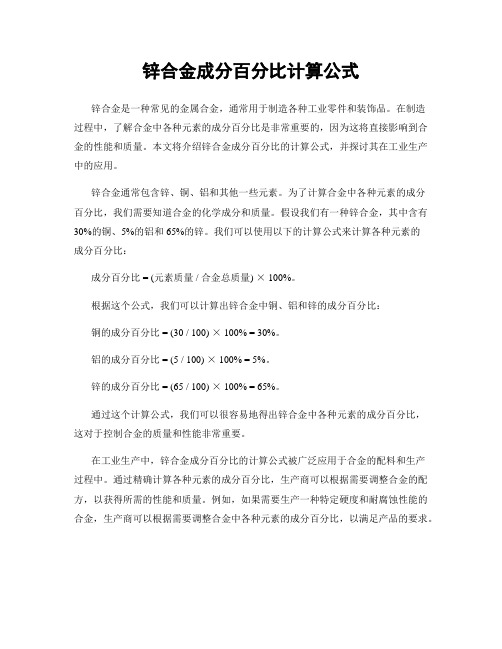
锌合金成分百分比计算公式锌合金是一种常见的金属合金,通常用于制造各种工业零件和装饰品。
在制造过程中,了解合金中各种元素的成分百分比是非常重要的,因为这将直接影响到合金的性能和质量。
本文将介绍锌合金成分百分比的计算公式,并探讨其在工业生产中的应用。
锌合金通常包含锌、铜、铝和其他一些元素。
为了计算合金中各种元素的成分百分比,我们需要知道合金的化学成分和质量。
假设我们有一种锌合金,其中含有30%的铜、5%的铝和65%的锌。
我们可以使用以下的计算公式来计算各种元素的成分百分比:成分百分比 = (元素质量 / 合金总质量) × 100%。
根据这个公式,我们可以计算出锌合金中铜、铝和锌的成分百分比:铜的成分百分比 = (30 / 100) × 100% = 30%。
铝的成分百分比 = (5 / 100) × 100% = 5%。
锌的成分百分比 = (65 / 100) × 100% = 65%。
通过这个计算公式,我们可以很容易地得出锌合金中各种元素的成分百分比,这对于控制合金的质量和性能非常重要。
在工业生产中,锌合金成分百分比的计算公式被广泛应用于合金的配料和生产过程中。
通过精确计算各种元素的成分百分比,生产商可以根据需要调整合金的配方,以获得所需的性能和质量。
例如,如果需要生产一种特定硬度和耐腐蚀性能的合金,生产商可以根据需要调整合金中各种元素的成分百分比,以满足产品的要求。
此外,锌合金成分百分比的计算公式也可以帮助生产商控制合金的成本。
通过精确计算各种元素的成分百分比,生产商可以避免过量使用昂贵的元素,从而降低生产成本。
这对于提高合金的竞争力和市场占有率非常重要。
除了在工业生产中的应用,锌合金成分百分比的计算公式也对于科研工作者和材料工程师来说是非常重要的。
通过精确计算合金中各种元素的成分百分比,科研工作者可以深入了解合金的性能和特性,为新材料的研发和应用提供重要的参考。
合金元素收得率公式

合金元素收得率公式
合金元素收得率公式,是用于评估合金冶炼过程中合金元素收集效率的数学表
达式。
具体而言,合金元素收得率是指在合金制备过程中,经过提炼和精炼操作后,最终得到的纯度较高的合金产品中,目标元素的百分比。
合金元素收得率公式通常表示为:收得率 = (目标元素的含量 * 合金产品质量)
/ (原料中目标元素的含量 * 原料质量) * 100%
其中,目标元素的含量指的是合金产品中所含目标元素的质量百分比,合金产
品质量指的是制备的合金产品的总质量。
原料中目标元素的含量指的是原料中所含目标元素的质量百分比,原料质量指的是投入到冶炼过程中的总原料质量。
合金元素收得率公式的计算可以帮助冶金工程师评估合金制备过程中元素的损
失情况,并根据评估结果采取相应的措施,以提高合金元素收集效率。
同时,该公式还可以用于优化合金制备过程,以降低生产成本并提高产品质量。
需要注意的是,合金元素收得率公式只是一个理论计算的工具,实际制备过程
中可能存在一定的损失和测量误差。
因此,在实际应用中,还需要结合实验数据和其他相关因素进行综合评估和分析,以确保结果的准确性和可靠性。
总结而言,合金元素收得率公式是冶金工程中一个重要的评估工具,可以帮助
冶金工程师计算合金制备过程中的合金元素收集效率,并指导相关措施的制定。
通过合理使用该公式,可以提高合金制备效率,降低成本,并获得更高质量的合金产品。
合金问题公式

合金问题公式
合金问题公式是用于解决合金材料相关问题的数学公式。
合金是由两种或更多种金属元素混合而成的材料,合金问题通常涉及到合金的成分比例、密度、质量等方面。
对于合金问题,我们可以使用下面的公式来求解:
1. 合金成分比例计算公式:
合金成分比例 = (合金中某金属元素的质量 / 合金的总质量) × 100%
2. 合金密度计算公式:
合金密度 = (金属元素1的质量占比 ×金属元素1的密度) + (金属元素2的质量占比 ×金属元素2的密度) + ...
3. 合金质量计算公式:
合金质量 = 金属元素1的质量 + 金属元素2的质量 + ...
这些公式可以用来解决以下问题:
1. 已知合金成分比例,如何计算某种金属元素在合金中的质量?
使用合金成分比例计算公式,将已知数据代入即可得到结果。
2. 已知合金的成分比例和某种金属元素的密度,如何计算合金的密度?
使用合金成分比例计算公式计算出各金属元素的质量占比,然后结合各金属元素的密度使用合金密度计算公式即可得到结果。
3. 已知合金的成分比例和各金属元素的质量,如何计算合金的质量?
直接将各金属元素的质量相加即可得到合金的质量。
注意,在使用这些公式进行计算时,需要确保数据的精确性和单位的统一。
合金问题公式能够帮助我们解决各种与合金材料相关的计算问题,提高工作效率和准确性。
合金表面能计算公式

合金表面能计算公式
合金表面能是描述合金表面活性和稳定性的一个重要参数。
合金表面能越低,表示合金表面越稳定,越不容易发生化学反应。
合金表面能的计算公式可以通过以下几个步骤来得到。
我们需要知道合金的成分和结构。
合金通常由两个或多个金属元素组成,每个元素的原子占据着不同的晶格位置。
合金的结构可以通过X射线衍射等实验方法来确定。
我们需要知道合金中各个成分的晶格能。
晶格能是指在晶格中每个原子与其周围原子之间相互作用的能量。
不同元素的晶格能可以通过实验或计算方法得到。
然后,我们需要计算合金表面的能量。
合金表面能是指单位面积上的能量,可以通过表面能的定义公式来计算。
表面能的定义公式是表面能等于表面自由能除以表面积。
表面自由能可以通过实验或计算方法得到。
我们可以根据合金的成分、结构、各个元素的晶格能和表面自由能来计算合金表面能。
合金表面能的计算公式可以通过将合金分解为单个元素的晶格能和表面自由能的加和来得到。
通过以上步骤,我们可以得到合金表面能的计算公式。
这个公式可以帮助我们评估合金的表面活性和稳定性,从而指导合金的设计和应用。
总结起来,合金表面能的计算公式是一个综合考虑合金成分、结构和表面性质的复杂计算过程。
通过计算合金表面能,我们可以评估合金的表面活性和稳定性,为合金的设计和应用提供指导。
这个公式的应用可以帮助我们更好地理解和控制合金的性能,进而推动材料科学和工程的发展。
镁合金重量计算公式

镁合金重量计算公式
镁合金重量计算公式是根据镁合金的密度和材料体积来计算的。
一般来说,镁合金的密度在1.7-2.0g/cm³之间。
如果已知镁合
金的体积,可以使用以下公式计算镁合金的重量:
重量 = 密度 ×体积
其中,重量单位可以选择克(g)或千克(kg),体积单位可
以选择立方厘米(cm³)或立方米(m³)。
需要注意的是,在实际应用中,还需要考虑到镁合金的成分和材料的浓度等因素对密度产生的影响。
因此,在具体应用中,需要根据实际情况进行修正和调整,以获得更精确的结果。
6063-t6铝合金重量计算

6063-t6铝合金重量计算摘要:I.简介- 介绍6063-t6 铝合金II.6063-t6 铝合金的特点- 概述6063-t6 铝合金的特性- 强度和耐蚀性- 重量和密度III.6063-t6 铝合金重量计算- 介绍计算6063-t6 铝合金重量的方法- 计算公式和步骤- 举例说明计算过程IV.总结- 概括6063-t6 铝合金重量计算的重要性- 重申6063-t6 铝合金的特点正文:I.简介6063-t6 铝合金是一种广泛应用于工业领域的铝合金,它以其良好的性能和较低的成本而受到欢迎。
这种合金主要包含镁、硅和铜等元素,具有中等强度和耐蚀性。
在许多应用中,6063-t6 铝合金的重量是一个重要的考虑因素。
因此,了解如何计算6063-t6 铝合金的重量非常必要。
II.6063-t6 铝合金的特点6063-t6 铝合金具有许多独特的特性,使其在各种应用中具有广泛的应用。
首先,它的强度和耐蚀性都相当不错,这使得它在需要承受一定压力和腐蚀环境下的应用具有优势。
其次,它的密度相对较低,这使得它在需要轻量材料的应用中具有竞争力。
在考虑6063-t6 铝合金的特性时,重量和密度是两个重要的因素。
了解这两个因素可以帮助工程师在设计时做出更明智的决策。
III.6063-t6 铝合金重量计算计算6063-t6 铝合金的重量对于工程师来说是非常重要的。
这可以通过使用以下公式来完成:重量(kg)= 体积(m)× 密度(kg/m)要计算6063-t6 铝合金的重量,首先需要知道其体积和密度。
体积可以通过测量长度、宽度和厚度来计算。
密度通常根据合金的成分和制造工艺来确定。
对于6063-t6 铝合金,密度通常约为2.8 g/cm。
例如,如果我们有一个6063-t6 铝合金的零件,其长度为10 cm,宽度为5 cm,厚度为2 cm,那么它的体积为10 cm × 5 cm × 2 cm = 100 cm。
铝条计算公式

铝条计算公式
算铝合金重量,可以使用质量公式M=ρV;
式中,M为质量;ρ为密度;V为体积;
铝合金的密度ρ为2.7g/cm^3
铝合金的体积V=长×宽×高,带入计算得V=60×80×85=408cm^3
所以:铝合金的重量为=2.7×408=1101.6g
铝合金物理特性
铝合金密度低,但强度比较高,接近或超过优质钢,塑性好,可加工成各种型材,具有优良的导电性、导热性和抗蚀性,工业上广泛使用,使用量仅次于钢。
一些铝合金可以采用热处理获得良好的机械性能、物理性能和抗腐蚀性能。
硬铝合金属AI—Cu—Mg系,一般含有少量的Mn,可热处理强化.其特点是硬度大,但塑性较差。
超硬铝属Al一Cu—Mg—Zn系,可热处理强化,是室温下强度最高的铝合金,但耐腐蚀性差,高温软化快。
锻铝合金主要是Al—Zn —Mg—Si系合金,虽然加入元素种类多,但是含量少,因而具有优良的热塑性,适宜锻造,故又称锻造铝合金。
母合金的计算方法
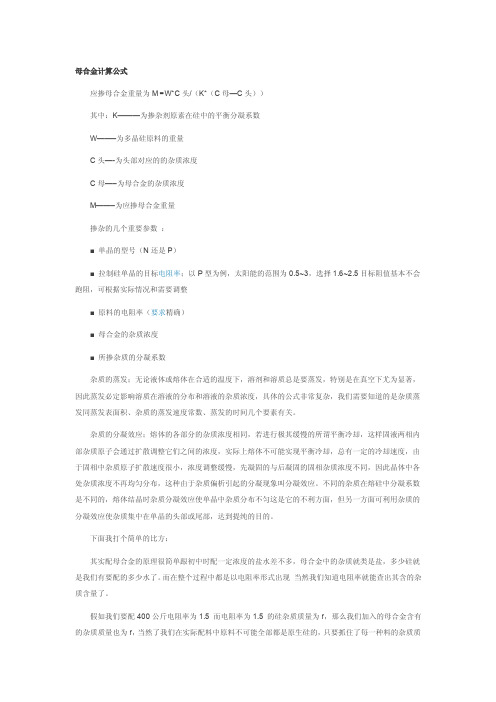
母合金计算公式应掺母合金重量为M =W*C头/(K*(C母—C头))其中:K———为掺杂剂原素在硅中的平衡分凝系数W——–为多晶硅原料的重量C头—-为头部对应的的杂质浓度C母—–为母合金的杂质浓度M——–为应掺母合金重量掺杂的几个重要参数:■ 单晶的型号(N还是P)■ 拉制硅单晶的目标电阻率;以P型为例,太阳能的范围为0.5~3,选择1.6~2.5目标阻值基本不会跑阻,可根据实际情况和需要调整■ 原料的电阻率(要求精确)■ 母合金的杂质浓度■ 所掺杂质的分凝系数杂质的蒸发;无论液体或熔体在合适的温度下,溶剂和溶质总是要蒸发,特别是在真空下尤为显著,因此蒸发必定影响溶质在溶液的分布和溶液的杂质浓度,具体的公式非常复杂,我们需要知道的是杂质蒸发同蒸发表面积、杂质的蒸发速度常数、蒸发的时间几个要素有关。
杂质的分凝效应;熔体的各部分的杂质浓度相同,若进行极其缓慢的所谓平衡冷却,这样固液两相内部杂质原子会通过扩散调整它们之间的浓度,实际上熔体不可能实现平衡冷却,总有一定的冷却速度,由于固相中杂质原子扩散速度很小,浓度调整缓慢,先凝固的与后凝固的固相杂质浓度不同,因此晶体中各处杂质浓度不再均匀分布,这种由于杂质偏析引起的分凝现象叫分凝效应。
不同的杂质在熔硅中分凝系数是不同的,熔体结晶时杂质分凝效应使单晶中杂质分布不匀这是它的不利方面,但另一方面可利用杂质的分凝效应使杂质集中在单晶的头部或尾部,达到提纯的目的。
下面我打个简单的比方:其实配母合金的原理很简单跟初中时配一定浓度的盐水差不多,母合金中的杂质就类是盐,多少硅就是我们有要配的多少水了。
而在整个过程中都是以电阻率形式出现当然我们知道电阻率就能查出其含的杂质含量了。
假如我们要配400公斤电阻率为1.5 而电阻率为1.5 的硅杂质质量为r,那么我们加入的母合金含有的杂质质量也为r,当然了我们在实际配料中原料不可能全部都是原生硅的,只要抓住了每一种料的杂质质量然后根据质量守恒,每种料的杂质质量之和为r就可以了。
合金重量计算公式

合金重量计算公式
合金重量计算公式可以根据合金的密度和体积来计算。
公式如下:
合金重量= 合金密度x 合金体积
其中,合金密度可以通过参考书籍或者在网上搜索获得。
合金体积可以通过测量合金的长度、宽度和高度来计算得到,或者在制造过程中直接控制。
需要注意的是,合金的密度和体积都需要以同一单位计算,以保证计算结果的准确性。
建议使用国际标准单位(SI单位),例如千克/立方米(kg/m³)作为密度单位,立方米(m³)作为体积单位。
在实际应用中,可能需要考虑到合金的成本、制造难度、性能等因素,综合考虑后选择合适的合金材料。
合金的体积电阻率计算方法

合金的体积电阻率计算方法合金的体积电阻率是指单位体积内的电阻值。
合金的体积电阻率可以通过以下方法进行计算。
了解合金的基本概念。
合金是由两种或两种以上金属元素混合而成的材料。
合金通常具有比单一金属更好的性能,如强度、硬度、耐腐蚀性等。
而合金的电阻率也与其成分和结构有关。
要计算合金的体积电阻率,需要知道合金的电阻和几何尺寸。
合金的电阻可以通过测量电流和电压来获得,而几何尺寸可以通过测量合金的长度、宽度和厚度来获得。
然后,根据合金的几何形状选择相应的计算公式。
对于常见的几何形状,如长方体、圆柱体和球体,可以使用不同的公式来计算体积电阻率。
例如,对于长方体,可以使用以下公式计算体积电阻率:体积电阻率 = (电阻× 长度) / (面积× 厚度)对于圆柱体,可以使用以下公式计算体积电阻率:体积电阻率 = (电阻× 长度) / (π × 半径^2)对于球体,可以使用以下公式计算体积电阻率:体积电阻率 = (电阻× 半径) / (4π × 厚度)根据所得到的计算结果,可以得出合金的体积电阻率。
体积电阻率的单位通常为Ω·m(欧姆·米)。
需要注意的是,合金的体积电阻率是与温度相关的。
随着温度的升高,合金的电阻率通常会增加。
因此,在进行计算时,需要考虑合金的工作温度。
总结起来,合金的体积电阻率可以通过测量合金的电阻和几何尺寸,并使用相应的计算公式进行计算。
了解合金的体积电阻率对于设计和应用合金材料具有重要意义,可以帮助工程师和科学家更好地理解和利用合金的性能。
- 1、下载文档前请自行甄别文档内容的完整性,平台不提供额外的编辑、内容补充、找答案等附加服务。
- 2、"仅部分预览"的文档,不可在线预览部分如存在完整性等问题,可反馈申请退款(可完整预览的文档不适用该条件!)。
- 3、如文档侵犯您的权益,请联系客服反馈,我们会尽快为您处理(人工客服工作时间:9:00-18:30)。
Ab-Initio Thermodynamics of Metal Alloys: From the Atomic to the Mesoscopic ScaleStefan M¨u llerUniversit¨a t Erlangen-N¨u rnberg,Lehrstuhl f¨u r Festk¨o rperphysikStaudtstr.7,91058Erlangen,GermanyAbstract.Density functional theory(DFT)based calculations allow us to study a number of metal alloy properties,as e.g.formation enthalpies,or electronic and elastic properties of intermetallic compounds.However,such so-called ab-initio cal-culations can only be applied as long as the alloy structure requires only small unit cells for the crystallographic description.It will be demonstrated how this limitation can be overcome without giving up the accuracy of DFT calculations by combin-ing them with so-called Cluster Expansion(CE)methods and Monte-Carlo(MC) simulations.This concept gives access to systems containing more than a million of atoms and therefore,permits to treat alloy properties which possess a delicate temperature-dependence.As examples,we discuss mixing enthalpies,short-range order,and precipitation without any empirical parameters as input,but with an accuracy that allows for the quantitative prediction of experimental results.1IntroductionThe increasing interest in metal alloys comes from their widefield of techni-cal applications ranging from lightweight cars and aircraft turbine blades to protective coatings in corrosive environments and magnetic devices.Beside experimental studies which are sometimes connected with a tremendousfi-nancial effort,more and more computer based approaches attract attention by many research groups.The set of all such theoretical methods forms a new discipline known as“computational materials science”.Indeed,this expres-sion includes a large number of different approaches reaching from contin-uum theory and semi-empirical accesses to so-calledfirst-principles methods, mostly based on density functional theory[1,2].Since the latter is strictly based on quantum-mechanical rules,it has a real predictive power,and–from a physical point of view–seems to be the most elegant solution to treat alloy problems.One should,however,keep in mind that we are already confronted with a many-body problem on a atomic scale and now,have tofind a way, how such calculations may be used to describe properties which are directly connected to the phase stability of an alloy,as e.g.short-range ordering.In principle,this demands to solve the following three problems:(i)The problem of bridging length scales:Many material properties take place on a mesoscopic or even macroscopic scale,i.e.model systems consisting of millions of atoms are necessary–a number far beyond the capacity of today’s computers.B.Kramer(Ed.):Adv.in Solid State Phys.44,415–426(2004)c Springer-Verlag Berlin Heidelberg2004416Stefan M¨u ller(ii)The problem of controlling huge configuration spaces:The validity of a pre-dicted ground-state diagram sensitively depends on the number of considered pared to the2N configurations of a binary alloy system con-taining N atoms,DFT calculations are restricted to a tiny part of this con-figuration space.So,normally a set of“intuitive candidates”is chosen and that with the minimum energy is postulated as ground-state.Naturally,this procedure fails to allow for surprises.(iii)The problem of treating configurational entropy:Ordering phenomena of alloys are temperature-dependent.This dependence cannot be treated by methods which only search the positional space.Instead,the configurational space must be taken into account allowing for exchange processes between individual atoms.It will be shown,how these problems can be overcome by combining DFT-based methods with concepts from statistical physics.Our focus will be on binary metal alloy systems.The structure of the present work is as follows: First the theoretical methods will be introduced(Section2).Then,the con-cept will be applied to two different alloy properties,namely precipitation (Section3)and short-range order(Section4).Finally,the limits and future possibilities will be briefly discussed in form of a summary(Section5).2MethodsThe concept of our theoretical approach is shown in Fig.1.The starting point builds DFT which is based on the Hohenberg-Kohn-theorem[1]stating that the energy of a system of interacting electrons in an external potential depends only on the ground state electronic density.In our case,namely the investigation of solid structures,the external potential is the Coulomb poten-tial caused by the nuclei in a solid.Since there exists a number of excellent review articles[3,4]and books[5,6,7]about DFT,no further details are given here.In a second step,the accuracy of DFT is extended to huge configura-tion spaces by combining DFT with concepts from statistical mechanics.The basic idea by Sanchez,Ducastelle and Gratias[8]is called“Cluster Expan-sion”(CE),and sketched in Fig.2:For a given underlying lattice,the crystal structure is divided into characteristicfigures such as pairs,triangles,etc. Then,the energy of any configurationσon this lattice can be uniquely writ-ten[8]as linear combination of the characteristic energies J of each individual figure.In practice,the only error we make is that the sum must be truncated at some point.TheΠ’s in Fig.1are structure-dependent factors.In practice,the construction of the so-called effective interactions J is done by an inversion method[11].This demands the calculation of the en-ergies for a set(typically15-50)of geometrically fully relaxed structures via DFT which are then used tofind that set of interactions,{J},which mini-mize the deviation between energies resulting from CE and DFT for all struc-turesσ.This procedure has to result in effective cluster interactions J whichAb-Initio Thermodynamics of Metal Alloys417Fig.1.The combination of DFT plus MSCE[9]plus MC[10]allows for a descrip-tion of phase stability of metal alloys on a mesoscopic scale without any empirical parametersFig.2.The concept of cluster expansions:The crystal is separated in characteristic figures(here,shown for the fcc-lattice).The energy of any configuration can then be written as linear combination of the characteristic energies J f of thefigures on the average only causes an additional prediction error of1-2meV/atom compared to the direct DFT energy.For this,the set of DFT input struc-tures must be varied until the effective interactions becomes stable,i.e.will not longer change,if an input structure is removed or added to the set of structures(for details,see.e.g.Ref.[12]).Moreover,asfirst shown by Laks et al.[13],any CE in real space fails to predict the energy of long periodic coherent superlattices–a prerequisite for studying precipitation on a meso-scopic scale fromfirst-principles.In principle,the problem can be solved by transforming a group of interactions to the reciprocal space which is eas-iest to do for the pair interactions and considering the long-periodic limit separately[13].Finally,this leads to the Hamiltonian of the“Mixed-Space Cluster Expansion(MSCE)”[9,13].Here,any configurationσis defined by418Stefan M¨u llerspecifying the occupations of each of the N lattice sites by an A atom(spin-indexˆS i=−1)or a B atom(ˆS i=+1).The formation enthalpy of any configurationσat its atomically relaxed state is then given by∆H CE(σ)=k J pair(k)|S(k,σ)|2+MBfD f J f¯Πf(σ)+(1)+14x−1k∆E eqCS(ˆk,x)|S(k,σ)|2.Thefirst two terms represent the chemical energy,E chem(often refered to as interfacial energy).Here,thefirst sum describes all possible pairfigures. J pair(k)is the lattice Fourier transform of the real space pair interactions,and S(k,σ)are structure factors.The second sum describes many-bodyfigures, such as triangles,tetrahedra,etc.J f is the real-space effective many-body interaction offigure f,D f stands for the number of equivalent clusters per lattice site and¯Πf(σ)are spin products.The third term,the constituent strain,E CS(often referred to as coherency strain),describes the strain en-ergy necessary to maintain coherency between bulk element A and B along an interface with orientationˆk.It can be calculated by deforming the bulk elements from their equilibrium lattice constants a A and a B to a common lattice constant a perpendicular toˆk.The constituent strain is a function of composition x and directionˆk only,but does not include information about the strength of chemical interactions between A and B atoms.Although the CE ansatz allows to treat physical problems ranging from few up to a million atoms without giving up the accuracy of modern DFT calculations,the concept still needs to be extended tofinite temperatures. This can be done by using the MSCE Hamiltonian,Eq.(1),in Monte-Carlo (MC)simulations(Fig.1).We even can extend thefield of applications to non-equilibrium processes by switching from thermodynamic MC to kinetic MC[14].For this,activation barriers for exchange processes between neigh-bor atoms have to be considered,and the number of possible exchange pro-cesses between atoms must be restricted to small atomic distances.For phase-separating processes,as the formation and aging of precipitates which will be studied next,a MC code was created which is strongly related to the concept of the so-called“residence time algorithm”[15].Here,atoms are forced to perform exchange processes and the time correlated to this process is calcu-lated afterwards[10].This algorithm is especially efficient for simulations of long aging times(many hours or days).3PrecipitationSolid state decomposition reactions like phase separation of an alloy into its constituents,A1−x B x (1−x)A+xB,create so-called precipitates which define an important part of the microstructure of many alloy systems.TheAb-Initio Thermodynamics of Metal Alloys419 early stage of these reactions typically involves the formation of coherent pre-cipitates that adopt the crystallographic lattice of the alloy from which they emerge[16].Coherent precipitates have practical relevance,as they impededislocation motion,and thus lead to“precipitation-hardening”in many al-loys[16,17,18,19].So,their size vs.shape distribution as function of tempera-ture and aging time is of special interest.Despite their importance,precipitatemicrostructures were thus far not amenable tofirst-principles theories,since their description requires“unit cells”containing103−106atoms or more.In experiment,precipitates are formed by quenching a solid solution deep intothe two phase-region of the phase diagram,followed by sample aging as shown in Fig.3for fcc-based Al-rich Al-Zn alloys.The formed coherent precipitates can then be observed via transmission electron microscopy(TEM)[20].The black spots are coherent fcc-Zn precipitates.Following the classical textbook of Khachaturyan[18]the shape of a pre-cipitate is controlled by two competing energies:While the interfacial orchemical energy leads to a compact shape,the strain energy leads to aflatten-ing along the elastically soft direction of the precipitate.Our MSCE Hamilto-nian easily allows for a separation into these two characteristic energy parts: As already mentioned in Section2,thefirst two terms of Eq.(1)includes information about strength and importance of the individual pair and multi-body interactions and therefore,represents the chemical energy of the system. The last term,however,reflects the elastic properties of the alloy.We usedFig.3.Quenching an Al-rich Al-Zn solid-solution into the two phase region of the phase diagram(left),followed by sample aging,leads to the formation of Zn-precipitates which can then be observed via TEM[20]in form of black spots(right)420Stefan M¨u llerthis simple physical picture to analyze the ratio between chemical energy E chem and strain energy E CS,as function of the precipitate size for three different Al-rich fcc based binary alloy systems,namely Al-Li,Al-Cu,and Al-Zn.The precipitate distributions are shown in Fig.4,whereby only the Li,Cu,Zn atoms are shown,respectively.For the MC simulations model sys-tems with up to one million atoms were necessary in order to receive sufficient statistics.In the case of Al-Li,precipitates neverflatten,but always possess a spher-ical shape.This becomes clear by analyzing E chem/E CS for different precipi-tate sizes as shown below the precipitate distribution images in Fig.4:In the case of Al-Li,for all precipitate sizes the chemical energy E chem(white bars) clearly dominates over the strain energy E CS(black bars).The Li atoms seem to form a simple cubic lattice.This is due to the fact that the precipitates themselves show a Al3Li stoichiometry forming the L12structure sketched on the top left corner of Fig.4:While all corners of the unit cell are occupied by Li atoms,all faces are occupied by Al atoms.Since only the Li atoms are displayed in the real-space image,they form a simple cubic lattice.This ob-servation also makes clear that there are practically no anti-phase boundaries within the Al3Li precipitates which would demand the occupation of Al sites by Li atoms.Analyzing E chem/E CS for Al-Cu,wefind the opposite is true than for Al-Li:The platelet-stabilizing strain energy is now the dominating part.So,precipitatesflatten along the elastically soft direction of Cu being the[100]direction[21].In the case of Al-Zn,the situation is more complex: Now,we see a strong size-dependence of the precipitate shape:Zn precipitates up to about2.5nm are more compact,i.e.chemically dominated,while larger precipitates becomes more and more ellipsoidal(strain dominated)[22].Since the most interesting size-shape relation is found for Al-Zn,we will now focus on this system.One remarkable feature of its coherent precipitates is the fact that their short axis is always along the[111](and symmetric equiv-alent)directions.Indeed,at afirst glance,this appears a bit as a surprise, because most fcc elements are elastically soft along the[100]direction,and consequently hard along[111].However,it should not be forgotten that we have to inquire about the stability and elastic properties of an unusual phase: fcc-Zn:While Zn is stable is the hcp structure,fcc-Zn shows an instability when deformed rhombohedrally along[111][23].As a consequent,fcc-Zn pre-cipitatesflatten along this direction[22].This feature allows the definition of a c/a ratio and therefore,a quantitative measure for the description of the precipitate shape as used in many experimental studies and schematically shown on the left side of Fig.5:While a represents the long axis of the ellip-soid(perpendicular to[111]),c is its thickness(parallel to[111]).The size is given by the radius of the associated sphere having the same volume as the corresponding precipitate.Figure5compares the experimental size-shape re-lation for two different aging times and concentrations[24,25,26,27,28]with those predicted from our method.For both temperatures,the agreement isAb-Initio Thermodynamics of Metal Alloys421Fig.4.Size-shape distribution of precipitates in Al-rich fcc based Al-Li,Al-Cu, and Al-Zn alloys(no Al atoms are shown)and their corresponding percentage of strain and chemical energy as function of the precipitate size.Precipitates of Al-Li form the L12structure as shown in the top left cornerFig.5.Shape(c/a)vs.size relation of Zn precipitates for two different tem-peratures.The lines denote the results from our calculations[29],the open points are taken from different experimental studies(exp.1-5correspond to Ref.[24,25,26,27,28])422Stefan M¨u llerexcellent,i.e.our ansatz allows for a quantitative prediction of the size versus shape versus temperature relation of coherent precipitates[29].4Short-Range Order and Mixing EnthalpiesIn general,all solid solutions of binary metal alloys show temperature-depen-dent short-range order(SRO).The MSCE Hamiltonian permit us to calculate SRO quantitatively by use of the Warren-Cowley SRO parameters given byαlmn(x)=1−P A(B)lmnx(2)where P A(B)lmn is the conditional probability that given an A atom at theorigin,there is a B atom at(lmn).For comparison with experimental data, the so-called“shells”lmn are introduced which are defined by the distancebetween A and B atoms in terms of half lattice parameters,(l a2,m a2,n a2),e.g.for an fcc-lattice the nearest-neighbor distance would be described by the shell(110),the second neighbor distance by(200)and so on.The sign ofαindicates whether atoms in a given shell prefer to order(α<0)or cluster(α>0).The SRO parameter may be written in terms of the cluster expansion pair correlations as[30]αlmn(x)= ¯Πlmn −q21−q2(3)where q=2x−1and ¯Πlmn are the mentioned structure-dependent factors (see Section2).In diffraction experiments the diffuse scattering due to SRO is proportional to the lattice Fourier transform ofαlmn(x)[31,32]α(x,k)=n Rlmnαlmn(x)e i·k·R lmn(4)where n R stands for the number of real space shells used in the transform. Equation(3)together with(4)opens the possibility to compare both,ex-perimental and theoretically predicted diffuse diffraction patterns(reciprocal space)and SRO-parameters(real space).As example,Fig.6compares experimental[33]and theoretical SRO pat-terns forα-brass[34].The patterns correspond to a sample with a Zn-concentration of31.1%at T=200◦C.Both patterns show SRO intensitiesaround k= 1140 .This reciprocal space vector is characteristic for the so-called D023structure which was earlier predicted as low-temperature ground state inα-brass[34].The structure belongs to the class of so-called long-periodic superlattices which are formed from the L12structure(which is sketched in Fig.4,top left corner)by anti-phase boundaries along the[001] direction.Their fundamental reciprocal space vector is k= 112M0 with MAb-Initio Thermodynamics of Metal Alloys423Fig.6.SRO-pattern for a Cu-Zn solid solution(T=200◦C,x Zn=0.31)resulting from neutron diffraction experiments[33]and from our calculation[34].In bothcases,SRO peaks around 1140 are visible favoring D023as low-temperature groundstate.Lower part:Corresponding SRO parameters and real space images Chains of Zn-atoms along[001]can be seenbeing the modulation wavelength.So,we see the highest intensity for the LPS structure with M=2being the D023structure.The SRO parameters can now be determined by a Fourier transformation of these SRO patterns.In experiment,they were used to construct a real space image of the alloy by using them as input for an inverse MC approach in order to obtain characteristic interactions[33].Figure6compares the real space structure deduced from experiment[33]and from our calculation.In both cases,chains of Zn atoms are visible along[001],indicating that short-range order is essential for a quantitative correct description of the physical properties of the disordered solid-solution ofα-brass.For a quantitative comparison of the computed SRO with experiment, Fig.6also gives the Warren-Cowley SRO parameterαlmn(Eq.(3))for the first5shells.Considering the fact that the experimental error ofα000amounts to be as large as8%(sinceα000=1.000by definition),the predicted and experimentally determined values agree very well.We see thatα110is nega-tive,indicating that Zn atoms prefer Cu atoms as nearest neighbors.Since SRO plays an important role inα-brass,it should also influence its energet-ics,i.e.the mixing enthalpy of the system should possesses a temperature-dependence.To clarify this,Fig.7compares calculated mixing enthalpies,∆H mix(x,T),for different temperatures with experimental data[35].We424Stefan M¨u llerFig.7.Calculated mixing enthalpies ofα-brass for different temperatures[34]and comparison with experimental data[35](bold line)start with the random alloy which is realized by an unphysically high tem-perature(T=105K),and go down to temperatures where SRO sets in. Comparing the energy curves for the random and the disordered alloy,we see that the calculation neglecting SRO leads to much higher mixing enthalpies. For higher Zn concentrations a good agreement between experiment and cal-culated mixing enthalpies can only be reached,if SRO is taken into account. 5SummaryThe applied combination of quantum mechanics(DFT)and statistical physics (MSCE,MC)certainly represents one of the most successful approaches to study binary alloy properties without any empirical parameters.At the mo-ment,the limitation of the presented access is given by the underlying lattice which does,for example,not permit to study melting processes.Regarding ordering phenomena in the solid phase,the presented results allow for a quan-titative prediction of experimental data.We have focused on two important alloy properties namely precipitation and short-range order(SRO).For the latter,it could be seen that a quantitative experiment-theory agreement can only be achieved,if the influence of SRO on the energetics of the disordered alloy is taken into account.This was demonstrated forα-brass,where an excellent agreement between experimental and calculated mixing enthalpies could be reached.As an important example for a decomposition reaction, precipitation in different fcc-based Al-rich solid solution were studied.Here, we profit by the fact that the approach applied allows to study configurationsAb-Initio Thermodynamics of Metal Alloys425 consisting of millions of atoms.In the case of Al-Zn,it was demonstrated that our prediction even goes through a quantitative comparison of the size-shape-temperature relation with experimental results.The presented method is by no means restricted to the two characteristic ordering phenomena,but can also be applied to e.g.surface problems as adsorbate systems[36]or surface segregation[37].Its application potential is up to now not yet clear.So,for example,after some further developments,it should be possible to describe properties as e.g.nucleation or island growth at surfaces.AcknowledgementsSpecial thanks go to Chris Wolverton,Alex Zunger,Lin-Wang Wang,Walter Wolf,Raimund Podloucky,and Long-Qing Chen for helpful discussions.Part of this work was supported by the US Department of Energy. References1.P.Hohenberg and W.Kohn,Phys.Rev.136,864B(1964).415,4162.W.Kohn and L.J.Sham,Phys.Rev.140,1133A(1965).4153.M.C.Payne,M.P.Teter,D.C.Allen,T.A.Arias,J.D.Joannopoulos,Rev.Mod.Phys.64,1064(1992).4164.R.O.Jones and O.Gunnarsson,Rev.Mod.Phys.61,689(1989).4165.R.M.Dreizler,E.K.U.Gross,Density Functional Theory(Springer,Berlin,1990).4166.R.M.Dreizler and J.da Providencia,Density Functional Theory(Plenum-Press,New York,1985).4167. E.S.Krachko and E.V.Ludena,Energy Density Functional Theory of Manyelectron Systems(Kluwer Academic,Boston,1990).4168.J.M.Sanchez,F.Ducastelle,D.Gratias,Physica A128,334(1984).4169. A.Zunger,NATO ASI on Statics and Dynamics of Alloy Phase Transforma-tions,eds.P.E.A.Turchi and A.Gonis,Plenum Press,New York,1994,p.361.41710.S.M¨u ller,L.-W.Wang,and A.Zunger,Model.Sim.Mat.Sci.Eng.10,131(2002).417,41811.J.W.D.Conolly and A.R.Williams,Phys.Rev.B27,5169(1983).41612.S.M¨u ller,J.Phys.:Condens.Matt.15,R1429-R1500(2003).41713. ks,L.G.Ferreira,S.Froyen and A.Zunger,Phys.Rev.B46,12587(1992).41714. A.F.Voter,Phys.Rev.B34,6819(1986).41815. A.B.B¨o rtz,M.H.Kalos,and J.L.Lebowitz,p.Phys.17,10(1975).41816. A.Guinier,Solid State Physics9,293(1959).41917.J.B.Cohen,Solid State Physics39,131(1986).41918. A.G.Khachaturyan,Theory of Structural Transformations in Solids(JohnWiley,New York,1983).419426Stefan M¨u ller19.H.W.Zandberger,S.J.Andersen,and J.Jansen,Science277,1221(1997).41920.R.Ramlau and H.L¨offler,Phys.Stat.Sol.(a)79,141(1983).41921. C.Wolverton,Phil.Mag.Lett.79,683(1999).42022.S.M¨u ller,C.Wolverton,L.-W.Wang,and A.Zunger,Acta Mater.48,4007(2000).42023.S.M¨u ller,L.-W.Wang,and A.Zunger,C.Wolverton,Phys.Rev.B60,16448(1999).420slaz,P.Guyot,Acta Metall.25,277(1977).420,42125. E.Bubeck,V.Gerold,G.Kostorz,Cryst.Res.Technol.20,97(1985).420,42126.M.Fumeron,J.P.Guillot,A.P.Dauger,and J.Caisso,Scripta Metall.14,189(1980).420,42127.J.Deguercy,M.F.Denanot,M.Fumeron,J.P.Guillot,et J.Caisso,ActaMater.30,1921(1982).420,42128.V.Gerold,W.Siebke,and G.Tempus,Phys.Stat.Sol.(a)104,213(1987).420,42129.S.M¨u ller,C.Wolverton,L.-W.Wang,and A.Zunger,Europhys.Lett.55,33(2001).421,42230.V.Ozoli¸nˇs,C.Wolverton and A.Zunger,Phys.Rev.B57,4816(1998).42231.M. A.Krivoglaz,X-Ray and Neutron Diffraction in Nonideal Crystals(Springer,Berlin,1996).42232. C.J.Sparks and B.Borie,in Local Arrangements Studied bx X-Ray Diffraction,eds.J.B.Cohen and J.E.Hilliard(Gordon and Breach,New York,Met.Soc.Conf.36,5(1966));B.Borie and C.J.Sparks,Acta Cryst.17,827(1964).42233.L.Reinhard,B.Sch¨o nfeld,and G.Kostorz,W.B¨u hrer,Phys.Rev.B41,1727(1990).422,42334.S.M¨u ller and A.Zunger,Phys.Rev.B63,094294(2001).422,423,42435.R.Hultgren,P.D.Desai,D.T.Hawkins,M.Gleiser,K.K.Kelley,SelectedValues of the Thermodynamic Properties of Binary Alloys(American Society for Metals,Ohio,1973).423,42436.R.Drautz,R.Singer,and M.F¨a hnle,Phys.Rev.B67,035418(2003).42537.O.Wieckhorst,S.M¨u ller,L.Hammer,and K.Heinz,Phys.Rev.Lett.,92,195503(2004).425。
